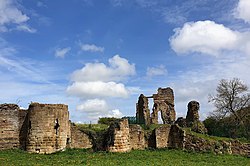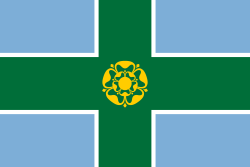| Codnor Castle | |
|---|---|
| Aldercar and Langley Mill, Amber Valley, Derbyshire | |
 Remains of Codnor Castle, viewed from the lower court | |
| Site information | |
| Condition | Ruined |
| Location | |
Shown within Derbyshire | |
| Coordinates | 53°02′43″N1°21′17″W / 53.0454°N 1.3548°W |
| Site history | |
| Built | 13th century |
| Materials | stone |
| Official name | Codnor Castle |
| Reference no. | 1007047 |
Listed Building – Grade II | |
| Official name | Remains of Codnor Castle, Castle Lane |
| Designated | 25 November 1963 |
| Reference no. | 1109025 |
Codnor Castle is a ruined 13th-century castle in Derbyshire, England. The land around Codnor came under the jurisdiction of William Peverel after the Norman Conquest. [1] The building is registered as a Scheduled Ancient Monument [2] a Grade II Listed Building [3] and is officially a Building at Risk. [4]


